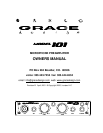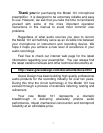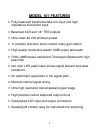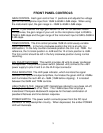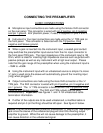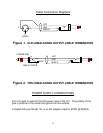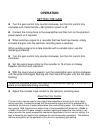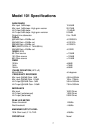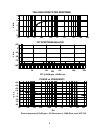
4
CONNECTING THE PREAMPLIFIER
AUDIO CONNECTIONS
l Microphone input connections are made using the female XLR connector
on the rear panel. This connector is wired with pin 2 positive, pin 3 negative
and pin 1 ground. 48V phantom power, if used, is supplied on pins 2 and 3.
l Instrument or line input connections are made using the ¼” TRS jack on
the front panel. This connector is balanced with the Tip positive, Ring
negative and Sleeve ground.
l When a jack is inserted into the instrument input, a sealed gold contact
relay switches the preamplifier input source from the mic input connector to
the front panel TRS jack. The input impedance of the instrument input is 1M
Ohm, which is ideal for inserting high impedance sources such as guitars with
passive pickups as well as any instrument with a high level output. Please
note that the gain range of the preamplifier when using the instrument input is
–10dB to +40dB.
l Using the instrument input with an unbalanced source is simple if a mono
¼” jack is used since the sleeve will automatically ground the inverting input
(ring) when plugged in.
l Output connections are made using the male XLR connector or the ¼”
TRS jack. The XLR connector is wired with pin 2 positive, pin 3 negative and
pin 1 ground. The ¼” TRS connector is balanced with the Tip positive, Ring
negative and Sleeve ground. The XLR and TRS outputs can be used
simultaneously. Important- See figures 1. and 2. for unbalanced cable
termination information.
l If either of the outputs are to be used unbalanced, a modified cable is
required and pin 3 (or the Ring) should be left open. See figure 2. below.
NOTE: It is not recommended to use an unbalanced ¼” plug in the TRS output
jack since the sleeve of the unbalanced plug will short the inverting output
amplifier to ground. While this will not cause damage to the preamplifier, it
can cause distortion in the unbalanced signal.



